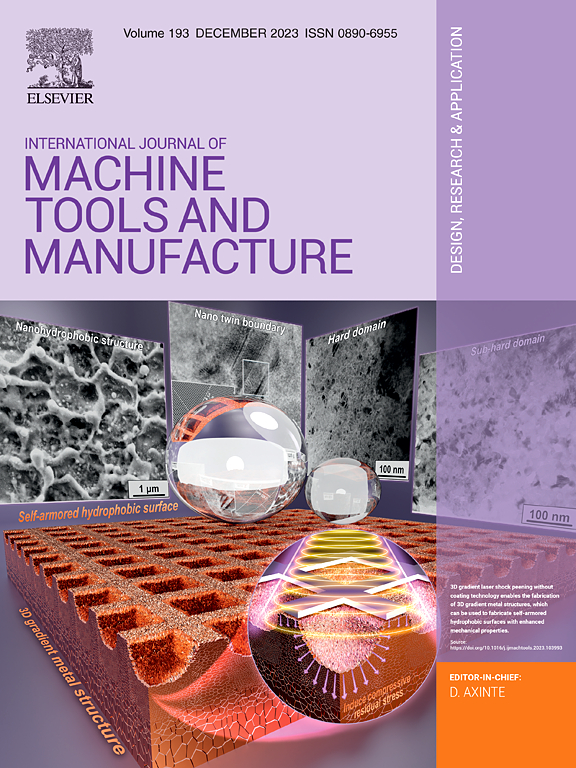通过异质变形纳米结构提高激光定向能沉积 IN718 超合金的强度-电导率协同效应
IF 18.8
1区 工程技术
Q1 ENGINEERING, MANUFACTURING
International Journal of Machine Tools & Manufacture
Pub Date : 2025-04-16
DOI:10.1016/j.ijmachtools.2025.104280
引用次数: 0
摘要
激光定向能沉积技术(LDED)在修复航空发动机的高温合金部件方面显示出巨大的前景,但通常会导致粗糙的显微组织、孔隙和拉伸残余应力。本文采用后处理超声冲击处理(UIT)有效调节led制造的IN718高温合金的表面组织和残余应力,增强了强度-塑性协同效应。通过系统地研究输出功率对表面粗糙度、孔隙率、变形微观结构、显微硬度分布、残余应力分布和拉伸行为的影响,实现了UIT工艺优化。建立了超声冲击残余应力场的有限元模拟模型,与实验结果吻合良好。单元诱导的大量位错和孪晶活动导致深度依赖的非均质变形纳米结构,包括顶部表面(<8 μm)的纳米晶粒和纳米层状复合结构的交替,密集的纳米孪晶(~ 30 μm深度),以及大量的位错缠结和堆积(~ 150 μm深度)。与未经处理的样品相比,经过最佳UIT参数处理的样品的屈服强度提高了约40%,而延性损失可以忽略不计。协同强化机制主要是加工硬化和边界强化。为了解耦这些影响,提出了一个与深度相关的位错种群和晶粒/纳米孪晶尺寸相关的定量框架,证明了与实验测量的良好一致性。保留的延性源于宏观变形脱域策略,由异质变形诱导应力、压缩残余应力和降低孔隙率促进,以及在微观尺度上实现变形调节的近表面非均质纳米结构。本研究阐明了通过表面非均质纳米结构增强的强度-延性协同作用,为高性能材料的增材制造提供了实践指导。本文章由计算机程序翻译,如有差异,请以英文原文为准。

Enhanced strength-ductility synergy in laser directed energy deposited IN718 superalloys through heterogeneous deformation nanostructures
Laser directed energy deposition (LDED) shows great promise for repairing superalloy components of aeroengines but often results in coarse microstructures, porosity, and tensile residual stresses. Herein, post-process ultrasonic impact treatment (UIT) is adopted to effectively regulate the surface microstructure and residual stresses in LDED-fabricated IN718 superalloys, enhancing the strength-ductility synergy. The UIT process optimization is achieved through a systematic investigation of the effect of output powers on surface roughness, porosity, deformation microstructure, microhardness distribution, residual stress profile, and tensile behavior. Particularly, a finite element model for simulating residual stress field induced by ultrasonic impact is established, showcasing excellent agreement with experimental measurements. UIT-induced substantial dislocation and twinning activities result in depth-dependent heterogeneous deformation nanostructures, including alternating nano-grains and nano-laminated composite structures on the top surface (<8 μm), dense nanotwins (∼30 μm depth), and substantial dislocation tangles and pile-ups (∼150 μm depth). Compared to untreated samples, the yield strength of the samples treated with optimal UIT parameters increased by ∼40%, with negligible ductility loss. The synergistic strengthening mechanisms are mainly attributed to the work hardening and boundary strengthening. To decouple these effects, a quantitative framework that correlates with depth-dependent dislocation populations and grain/nanotwin sizes is proposed, demonstrating good consistency with experimental measurements. The preserved ductility stems from a macroscopic deformation delocalization strategy facilitated by the hetero-deformation induced stress, compressive residual stress, and reduced porosity, together with the near-surface heterogeneous nanostructures enabling deformation accommodation at the micro-scale. This work elucidates the enhanced strength-ductility synergy through surface heterogeneous nanostructures and provides practical guidance for the additive manufacturing of high-performance materials.
求助全文
通过发布文献求助,成功后即可免费获取论文全文。
去求助
来源期刊
CiteScore
25.70
自引率
10.00%
发文量
66
审稿时长
18 days
期刊介绍:
The International Journal of Machine Tools and Manufacture is dedicated to advancing scientific comprehension of the fundamental mechanics involved in processes and machines utilized in the manufacturing of engineering components. While the primary focus is on metals, the journal also explores applications in composites, ceramics, and other structural or functional materials. The coverage includes a diverse range of topics:
- Essential mechanics of processes involving material removal, accretion, and deformation, encompassing solid, semi-solid, or particulate forms.
- Significant scientific advancements in existing or new processes and machines.
- In-depth characterization of workpiece materials (structure/surfaces) through advanced techniques (e.g., SEM, EDS, TEM, EBSD, AES, Raman spectroscopy) to unveil new phenomenological aspects governing manufacturing processes.
- Tool design, utilization, and comprehensive studies of failure mechanisms.
- Innovative concepts of machine tools, fixtures, and tool holders supported by modeling and demonstrations relevant to manufacturing processes within the journal's scope.
- Novel scientific contributions exploring interactions between the machine tool, control system, software design, and processes.
- Studies elucidating specific mechanisms governing niche processes (e.g., ultra-high precision, nano/atomic level manufacturing with either mechanical or non-mechanical "tools").
- Innovative approaches, underpinned by thorough scientific analysis, addressing emerging or breakthrough processes (e.g., bio-inspired manufacturing) and/or applications (e.g., ultra-high precision optics).

 求助内容:
求助内容: 应助结果提醒方式:
应助结果提醒方式:


